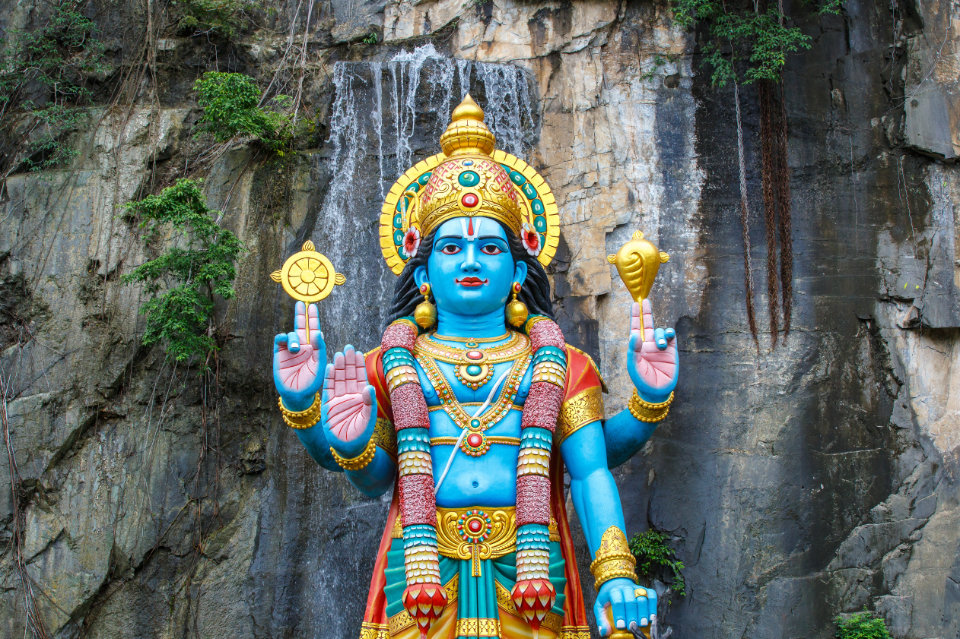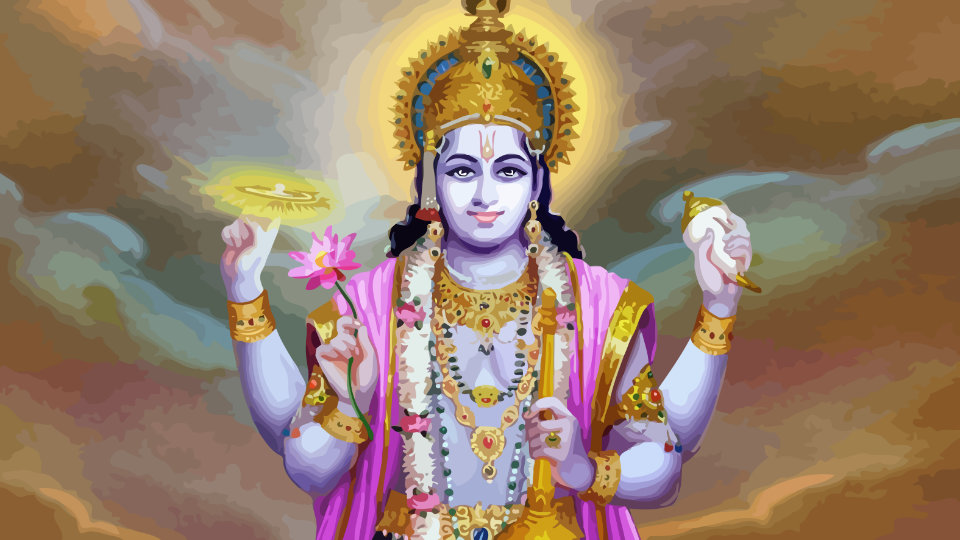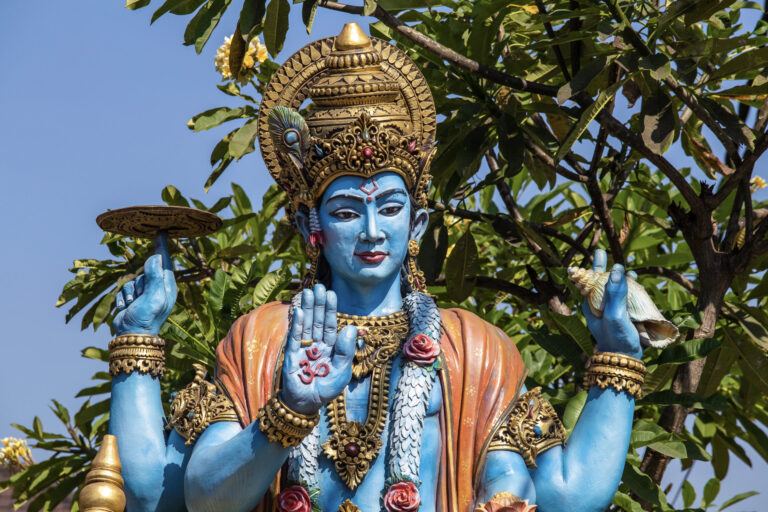In the intricate mosaic of Hinduism, God Vishnu is revered as the quintessential force of preservation and balance. Known as the ‘Preserver’ within the Trimurti, or Hindu Trinity, he is the embodiment of mercy and goodness, maintaining the universe’s order.
Beyond India, Vishnu’s influence extends to other religions and countries, reflecting a shared reverence for his virtues. In certain Buddhist traditions, Vishnu is recognized and venerated, demonstrating the interconnectedness of Eastern philosophies.
His worship is widespread, spanning cultures and geographies, from Bali to Nepal, where he is celebrated for his role in sustaining the world and ensuring spiritual equilibrium.
Table of Contents
The Many Avatars of God Vishnu
Vishnu, in Hinduism, is the protector of the universe and the embodiment of mercy and goodness. He is known for incarnating in various forms, known as ‘avatars’, to restore balance in the world whenever it is threatened by evil.
The ten principal avatars, collectively known as the Dashavatara, are:
- Matsya – The Fish, who saved the Vedas from a deluge.
- Kurma – The Tortoise, who supported the churning of the ocean.
- Varaha – The Boar, who lifted the Earth from the ocean.
- Narasimha – The Man-Lion, who destroyed the demon Hiranyakashipu.
- Vamana – The Dwarf, who subdued the king Bali.
- Parashurama – The warrior with an axe who checked the tyranny of kshatriyas.
- Rama – The prince and king of Ayodhya, who killed the demon king Ravana.
- Krishna – The divine statesman and warrior who played a key role in the Mahabharata.
- Buddha – The enlightened one who taught the path of non-violence and truth.
- Kalki – The prophesied future avatar who will end the current age of darkness and corruption.
Each avatar of Vishnu has a specific purpose, reflecting the needs of the cosmos at a particular time, and is deeply revered in various Hindu traditions.
God Vishnu’s Iconography and Symbols
Vishnu’s iconography is rich and symbolic, often shown in a peaceful and calm state, lying on the serpent Ananta or standing with his consort, Lakshmi.
His four arms represent his omnipresence and omnipotence, and the objects he holds are symbols of his divine qualities:
- Conch (Shankha) – Represents the primal sound from which creation developed and is used to signify the spread of divine sound “Om”.
- Discus (Chakra) – Symbolizes the mind and Vishnu’s command over the universe.
- Lotus (Padma) – A symbol of purity and transcendent beauty.
- Mace (Gada) – Represents the power of knowledge and physical strength.
The eagle Garuda, his mount, stands for courage and speed, and is a symbol of Vedic knowledge. Together, these symbols represent Vishnu’s role as the preserver and the bringer of life and order to the cosmos.
In temples and during worship, these symbols are given great importance, and pujas often involve offerings that represent these attributes of Vishnu. Devotees reflect on these symbols to draw closer to the deity and imbibe his qualities in their lives.
The Abode and Worship of God Vishnu
Vishnu’s celestial home is Vaikuntha, a place of eternal bliss. Devotees often engage in puja (ritual worship) to honor him, which includes chanting mantras, offering flowers, and performing arati.

Praying to God Vishnu – A Step-by-Step Guide
Praying to God Vishnu involves specific rituals and practices that are deeply rooted in respect and devotion. Here is a guide:
Preparation:
- Physical and Mental Cleanliness: Take a bath and wear clean clothes. Mentally prepare by calming your mind, possibly through meditation.
- Clean the Puja Area: Ensure the area where you will perform the puja is clean and free of clutter.
Offerings:
- Items for Puja: Have sandalwood paste, flowers (especially lotus or tulsi), incense sticks, and a lamp ready.
- Food Offering: Prepare vegetarian dishes or sweets as prasad (a devotional offering).
Rituals:
- Invocation: Light the lamp and incense sticks. Begin by praying to Ganesha to remove obstacles from the puja.
- Vishnu Mantras: Chant the Vishnu mantras with devotion, ideally 108 times using a japa mala (prayer beads).
Taboos and Considerations:
- Avoid Non-Vegetarian Food: On the day of worship, abstain from non-vegetarian food and alcohol.
- Sincerity in Prayer: Approach the puja with sincerity, not merely as a formality.
- Focus on the Deity: Ensure your thoughts remain on Vishnu throughout the puja.
Post-Ritual Practices:
- Prasad Distribution: Share the offered food with others as a blessing from the deity.
- Daily Worship: Regular daily worship can deepen the connection with the deity.
Special Observations:
- Fasting: Some devotees choose to fast on days dedicated to Vishnu, like Ekadashi.
- Festivals: Participate in Vishnu-related festivals for enhanced spiritual benefits.
- Who and Why: The mantra is for those seeking protection, well-being, and spiritual growth. It’s believed to create positive vibrations and align the devotee with the divine.
- Where to Pray: While a temple is ideal, a quiet spot at home can also be a sanctified place for prayer.
Remember, the intention behind the prayer often holds as much significance as the ritual itself.
Mantra for God Vishnu
Here are some mantras dedicated to Lord Vishnu:
- Vishnu Mool Mantra is a powerful incantation that can be chanted to invoke Lord Vishnu’s blessings for overall prosperity, happiness, and protection.
Om Namo Bhagavate Vasudevaya॥ - Vishnu Bhagawate Mantra is another version of the Mool Mantra, which is chanted to seek Lord Vishnu’s divine guidance and to remove obstacles from one’s path.
Om Namo Bhagawate Vasudevaya Namah॥ - Shantakaram Bhujaga Shayanam Mantra is recited for inner peace and calmness. It’s also a mantra of protection against fear and to seek blessings for stability in life.
Shantakaram Bhujaga Shayanam Padmanabham Suresham। Vishwadharam Gagan Sadrisham Meghavarnam Shubhangam॥ Lakshmi Kantam Kamala Nayanam Yogibhir Dhyana Gamyam। Vande Vishnum Bhava Bhaya Haram Sarva Lokaiaka Natham॥ - Shree Vishnu Mantra is similar in its effects to the Shantakaram mantra, promoting peace, tranquility, and offering protection from fears and perils.
Shaanta-Aakaaram Bhujaga-Shayanam Padma-Naabham Sura-Iisham। Vishva-Aadhaaram Gagana-Sadrsham Megha-Varnnam Shubha-Anggam॥ Lakssmii-Kaantam Kamala-Nayanam Yogibhir-Dhyaana-Gamyam। Vande-Vishnum Bhava-Bhaya-Haram Sarva-Loka-Eka-Naatham॥ - Mangalam Bhagwan Vishnu Mantra is a benedictory mantra that is often recited at the end of prayers and pujas to wish for auspiciousness and well-being from Lord Vishnu for all beings.
Mangalam Bhagwan Vishnuh, Mangalam Garunadhwajah। Mangalam Pundari Kakshah, Mangalaya Tano Harih ॥.
Vishnu in Sacred Texts
Lord Vishnu’s presence in sacred texts extends beyond the well-known Bhagavad Gita. He is central to numerous Puranas, which are ancient Indian texts eulogizing various deities through divine stories.
In the Gita, part of the Mahabharata’s Bhishma Parva, Vishnu, in his avatar as Krishna, imparts the spiritual discourse of duty and righteousness to Arjuna, offering insights that have transcended religious boundaries to provide moral and ethical guidance.
Vishnu’s narratives in the Puranas often illustrate his role as the protector and preserver of the universe, intervening whenever cosmic order is threatened.

Philosophical Schools and Vishnu
Vaishnavism is one of the major traditions within Hinduism that reveres Lord Vishnu as the Supreme Being. It emphasizes the concepts of devotion (bhakti) and surrender to Vishnu and includes a diverse array of practices, from temple worship to personal meditation on the deity’s name and form.
The philosophical schools within Vaishnavism interpret Vedantic teachings to explain the relationship between the soul (atman), the universe, and the divine.
Prominent among these are the schools of Ramanuja, Madhva, and Chaitanya, which differ in their understanding of the nature of the relationship between the individual soul and the Supreme soul, Vishnu.
God Vishnu’s Consorts and Their Roles:
Vishnu is often depicted alongside his consort, Goddess Lakshmi, who is the embodiment of wealth and prosperity. Lakshmi’s role is not limited to material wealth; she is also the source of spiritual richness and is integral to Vishnu’s function as the preserver of the universe.
She aids in the maintenance of dharma (order) and provides devotees with the fortune necessary to live virtuous lives. Another consort, Bhudevi, symbolizes the Earth, emphasizing the idea of Vishnu as the protector of the world and all its forms of life.
Modern-Day Worship and Cultural Impact:
In modern times, Lord Vishnu’s teachings and values continue to permeate various aspects of life for millions of followers. Daily prayers, temple rituals, and festivals like Diwali and Holi are infused with the worship of Vishnu and Lakshmi, underscoring their importance in contemporary devotion.
The portrayal of Vishnu in dance, music, and theater, as well as his influence on literature and philosophy, showcases the enduring cultural impact of his narratives.
His principles of preservation, righteousness, and compassion are seen as guiding lights for ethical living in the present day.
Reflections on the Path of God Vishnu Worship
God Vishnu’s worship encapsulates the essence of Hindu devotion, merging mythos, age-old customs, and deep-seated philosophical tenets, steering adherents toward serenity and higher awareness.
This spiritual practice aligns with the reverence of other deities, each offering unique insights and blessings.
Discover the significance of worshipping Guan Gong, a symbol of loyalty and justice; worshipping Tua Pek Kong, the deity of prosperity and safety; worshipping Goddess of Mercy, embodying compassion; and worshipping 4-faced Buddha at Erawan Shrine for comprehensive blessings.
Similarly, worshipping Tiger God is believed to grant courage and protection. Each path of worship provides a unique tapestry of faith and spirituality.
Who is Lord Vishnu in Hindu mythology?
Lord Vishnu is one of the principal deities of Hinduism, known as the Preserver or the Protector within the Hindu Trinity (Trimurti) that includes Brahma the Creator and Shiva the Destroyer. He is revered for maintaining the order and harmony of the universe.
How many avatars does Lord Vishnu have?
Traditionally, Lord Vishnu is said to have ten avatars, known as the Dashavatara. These include well-known incarnations like Rama and Krishna, as well as others like Matsya (the fish) and Narasimha (the half-man, half-lion).
What does Lord Vishnu symbolize?
Lord Vishnu symbolizes preservation and the cosmic order. His role is to return to the earth in troubled times to restore the balance of good and evil, thus maintaining the cosmic laws and harmony.
Where is Lord Vishnu primarily worshipped?
Lord Vishnu is worshipped across India and in other countries with Hindu populations. He is also venerated in various forms in some Buddhist traditions across Asia, illustrating his broad influence and the syncretism present in Eastern spiritual practices.
Why does God Vishnu have four hands?
God Vishnu’s four hands represent his omnipresence and omnipotence. The two front hands signify his activity in the physical world, and the two back hands indicate his presence in the spiritual world, symbolizing the mind’s power over matter.
What weapons does God Vishnu hold, and why?
God Vishnu holds four items: a conch shell (shankha), which symbolizes the divine sound of creation; a discus (chakra), representing the mind; a lotus (padma), symbolizing spiritual liberation; and a mace (gada), indicative of mental and physical strength.
What is the power of God Vishnu?
The power of God Vishnu lies in his role as the Preserver of the Universe. He maintains order and harmony, protecting the world from chaos. Vishnu’s power also includes creating and sustaining life, as well as offering salvation and mercy to his devotees.
What is the mantra of Lord Vishnu?
One of the most revered mantras for Lord Vishnu is “Om Namo Narayanaya“, which is chanted for protection, well-being, and spiritual clarity. Another significant mantra is “Om Namo Bhagavate Vasudevaya“, invoking his divine presence and blessings.
Why pray to God Vishnu?
Praying to God Vishnu is believed to bring balance, protection, and preservation to one’s life. As the sustainer of the universe, he ensures the maintenance of cosmic order. Devotees pray to Vishnu for spiritual growth, inner peace, and to seek his divine grace in overcoming life’s challenges and obstacles. His blessings are sought for prosperity, harmony, and the upliftment of the soul toward moksha (liberation).



